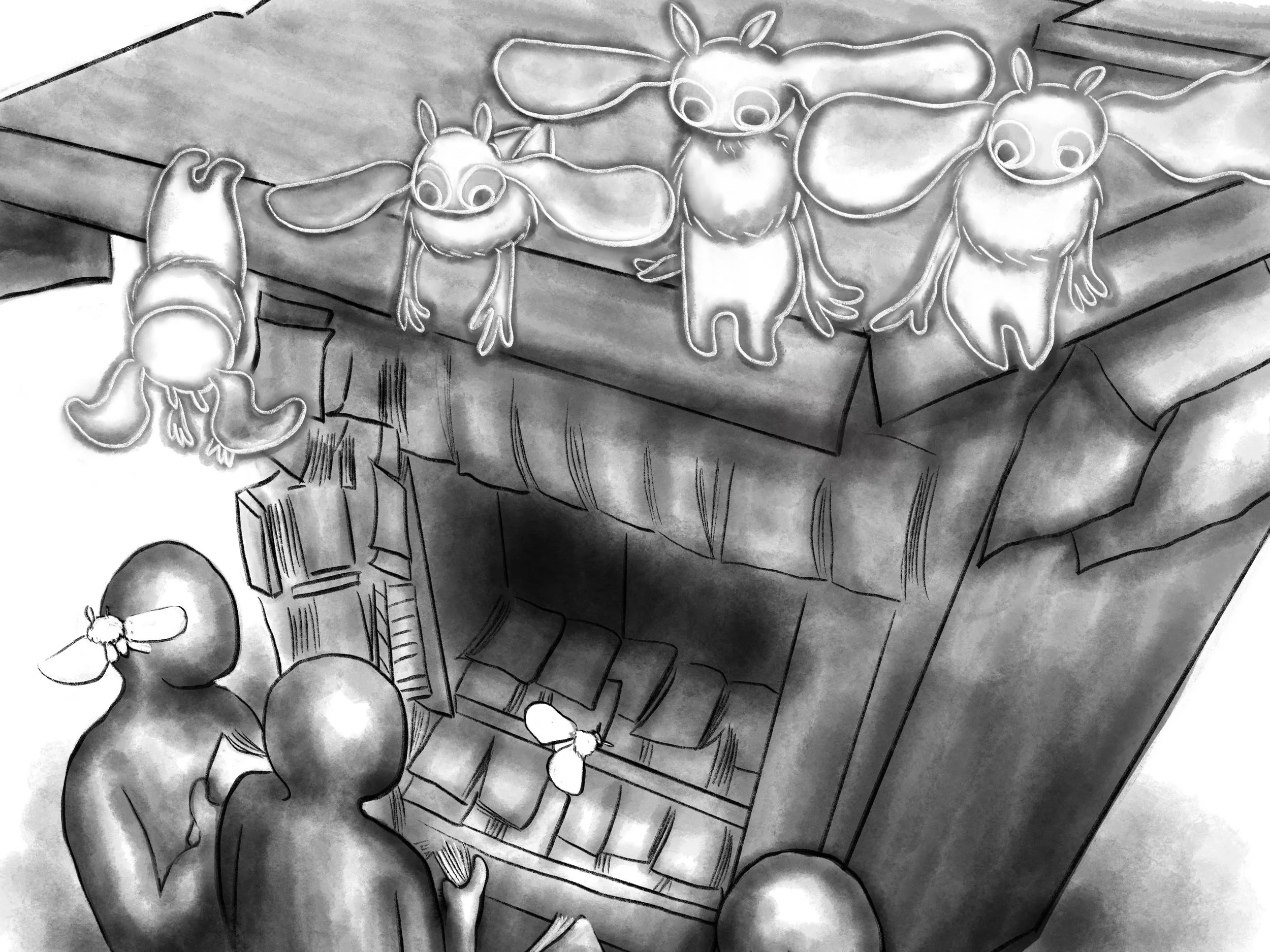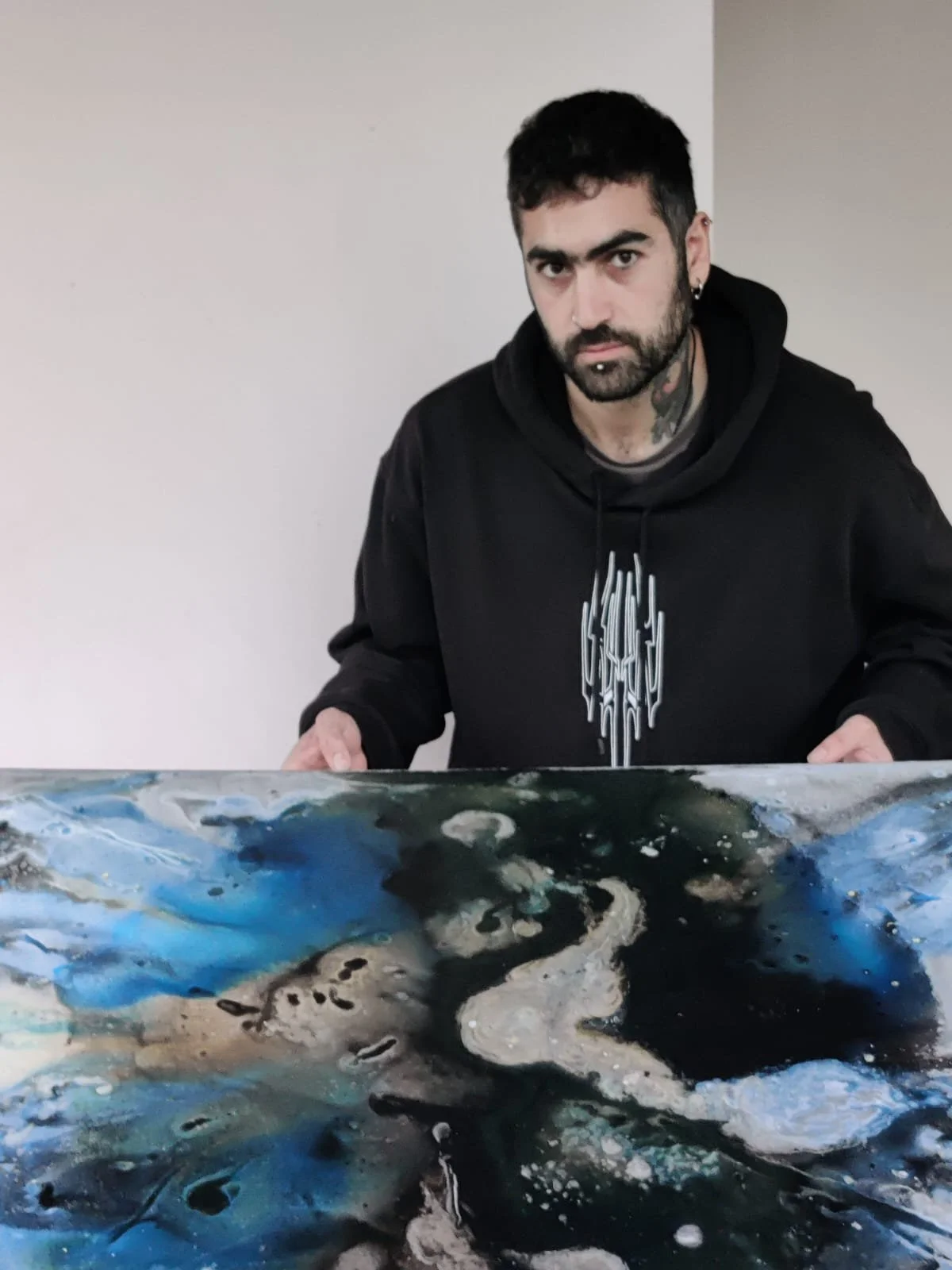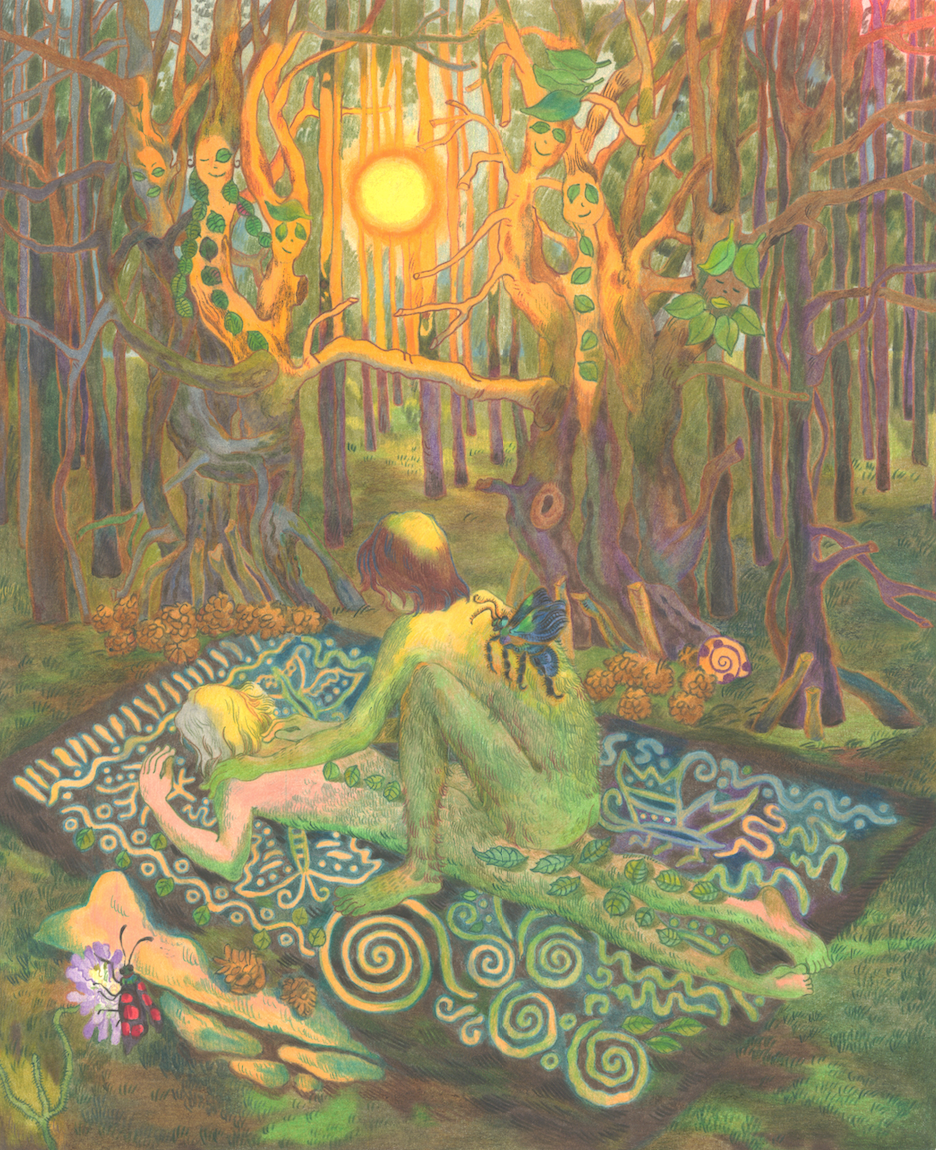INTERVIEW | Minglu Du
10 Questions with Minglu Du
Minglu Du, born in 1998 in Guiyang, China, is an interdisciplinary artist currently based in Providence, USA, and Shanghai, China. She works across illustration, experimental animation, digital games, and installation, often incorporating literature and soundtracks. Known for her depiction of human figures as metaphorical metallic forms and surreal creatures, Du's work explores societal inequalities through thick, twisted forms, sharp color contrasts, and metallic textures designed to evoke strong emotional responses.
Du's subject matter focuses on unrepresented and silenced groups, traumatized individuals, and queer experiences. Her work is characterized by its ability to merge metaphorical narratives with surreal aesthetics. Notable projects include The Newsstand's Tale (2022), a frame-by-frame animation addressing the disappearance of newsstands due to the rise of digital media, and We Are Not What We Are (2023), a poignant exploration of the global queer community's resistance to imposed labels and embrace of individuality.
Minglu Du has participated in several notable exhibitions, including éphémère ~ London Experimental Film (2024) in London, UK; Pride: All Day, Every Day (2024) in New York, USA; and As We Are: The 2nd Annual Pride Gallery Show (2024) in Providence, USA. Her work has also been featured in group exhibitions such as the Illustration Graduate Program Summer Show and Arriving at the Exit: The Inaugural Illustration Graduate Biennial Group Show (2024), both in Providence.
Minglu Du - Portrait
ARTIST STATEMENT
Minglu Du (b. 1998, Guiyang, China) is a queer interdisciplinary illustrator based in Providence, USA, and Shanghai, China. Her work spans digital illustration, experimental animation, games and installations, often combining literature and soundtracks to create immersive and narrative-oriented experiences. Influenced by her experiences as a woman born and raised in a patriarchal society, Du explores personal and socio-political subjects focusing on marginalized, silenced, and traumatized communities.
Du's art is characterized by a surreal aesthetic, blending imaginative, otherworldly elements with thick, twisted forms, sharp color contrasts, and metallic textures. These distinct features evoke strong emotional responses, while human figures often appear as metaphorical forms or surreal creatures, symbolizing societal inequalities. Themes of trauma, pain, and resistance are central to her work, which seeks to inspire empathy and provoke critical dialogue.
Beginning her career in 2022, Du initially avoided personal narratives, concentrating instead on group-oriented depictions. By 2024, she embraced the relevance of her own experiences as a way to connect audiences with broader community issues. This shift coincided with a more cohesive stylistic approach, emphasizing metallic textures and bold visual contrasts.
As a believer in the power of storytelling, Du creates immersive narratives through moving images, including animation, games, and graphic novels, inviting viewers to empathize with her characters' emotional journeys. She describes her approach as embracing chaos to draw attention to societal issues, using fear and curiosity as tools to encourage reflection and raise questions.
The Ancestors' Saying, Digital Illustration, 40x25 cm, 2023 © Minglu Du
INTERVIEW
Can you tell us about your background and what inspired you to become an artist?
I come from a family with an artistic background. My mother was a dancer and theatre actress, and my father was a singer. However, as artists often faced the challenge of making a living in their time, both my parents went on to pursue other occupations. Despite this, their love for the arts never wavered, and their sensitivity to creativity left a lasting impact on me from an early age.
Although my interest in drawing began early - in fact, as early as kindergarten - it was not until I was 18 that I had the support of my parents to pursue a career in art. They were understandably concerned about the practical difficulties of a life in art and, in many ways, wanted to protect me from those challenges.
I initially studied European Studies at the Hong Kong Baptist University, which may seem a long way from the art world, but I found the experience highly valuable. Studying social sciences gave me the tools to understand and analyze both my personal experiences of pain and injustice and the broader social and political dynamics that shape these issues. It was during my time at university that I began to experiment with illustration and animation as a way of expressing my perspectives on social issues. I was attracted to these mediums because they provide an accessible platform for communicating complex ideas to a wide audience - far beyond the academic circles that typically engage with more traditional forms of scholarship.
After completing my undergraduate degree, I spent several years working in other fields to support my artistic practice. In 2023, I made the decision to formalize my education and pursue an MFA in Illustration at the Rhode Island School of Design. I think this transition marked a commitment to enhance my skills and fully dedicate myself to my career as an artist.
You work across illustration, experimental animation, digital games, and installations. What draws you to these different mediums, and how do they influence each other?
For me, the medium is never the starting point. It's always about what I want to express and the emotions I want to evoke in the audience. Emotion is the dominant force in my creative process, and as an artist whose primary focus is illustration, my goal is always to communicate emotions and messages as effectively as possible. This often leads me to consider how different mediums can enhance this communication. For example, I ask myself: can traditional illustration - whether in books or prints - successfully convey the depth of emotion I'm aiming for? Would adding sound through animation or interactivity in games create a more immersive experience? What about installations, where the physical presence of the work engages the viewer's body and senses in a different way? I'm particularly fascinated by how engaging multiple senses: sight, touch, hearing, and even smell, which I believe can influence perception and emotion separately and together.
Working across different mediums has also shown me how they can influence and enhance each other. For instance, my style is often dense and metallic, which makes the static shapes feel heavy and intense. But when these images are set in motion through animation or paired with sound and interaction in a game or installation, they can convey contrasting feelings of lightness or fluidity. This interplay of media feels like an experiment. Each project is like cooking a new dish, where the ingredients are the mediums that I combine to produce specific reactions. I see myself as an equal to the audience in this process: we are both participants in discovering the emotional and sensory outcomes of these combinations. This mutual exploration is what excites me most about working across forms.
Club Bathroom, Digital Illustration, 40x30 cm, 2023 © Minglu Du
Your work often features human figures as metallic forms or surreal creatures. What do these forms represent, and how did you develop this unique visual style?
My current style wasn't the result of deliberate research or exploration. Instead, it emerged during one of the most difficultand confusing periods of my life. Between 2021 and 2022, I was dealing with the combined effects of the pandemic, the struggles of living with psychological disorder, and the systematic societal exclusion of sexual minorities in my community. It was an incredibly dark time and I often felt lost as to where my future lay.
In these moments of pain and confusion, I chose to sit at my desk and draw aimlessly, experimenting with different brushes and textures without any clear intention. It was during these mindless sessions that I stumbled upon this strange metallic texture - as if it carried the sound of friction itself. I admit this all sounds very dramatic, but it just happened. I was in a period of pain and confusion, and my doodling during that period evolved into my current dominant visual style.
Themes like societal inequalities, trauma, and queer experiences are central to your work. Why are these topics important for you to explore?
I think that from childhood, both those around me and I myself often saw me as “an unhappy person.” In my creative process, my focus on themes such as social inequality, trauma, and queer experiences—topics often associated with heavy emotions—seems to have only reinforced this label. However, this does not mean that my life has been particularly more complex or tragic than most. In fact, simply having access to higher education already makes me more privileged than many. Perhaps I was just a sensitive child with a love for reading, expression, and a sense of empathy, who always tried to seek answers to everything sorrowful.
No one is born a saint. Like many others who eventually turn their focus toward social issues, I came to recognize the collective nature of trauma—and the societal forces that shape it—while searching for answers to my own pain. Proposing solutions is often difficult, but I can attempt to present the struggles connected to my experiences, as well as the various ways (both constructive and destructive) that people navigate these struggles. I believe that for both myself and those who resonate with my narrative, the attempt to be "seen" and "heard" may not be a universal remedy for suffering, but it is, at the very least, an act of honoring the past, and perhaps, also the first step in encouraging us to move forward.
Island, 2D Animation, 1920x1080 px, 2022 © Minglu Du
The Newsstand's Tale, 2D Animation, 5’ 29’’2022 © Minglu Du
In projects like The Newsstand’s Tale and We Are Not What We Are, you focus on disappearing traditions and the global queer community. How do you approach storytelling in these works?
The inspiration for The Newsstand's Tale comes from the struggles faced by newsstand operators as the print media industry declines. Through my research, I discovered that for many of these operators, keeping their newsstands running is not just about making a living—some even spend more than they earn—but also about preserving a sense of dignity as former guardians of news access in modern cities. I was deeply moved by their dedication, yet saddened by the reality that many of these operators, most of whom are middle-aged or elderly, receive little to no social support after losing their livelihoods.
Based on this research, I created a mysterious, cute creature: the Newsstand Elf. These tiny beings symbolize the newsstand operators, drawing their life force from the public’s demand for print media. They dwell in the cramped spaces of the newsstands, peeking out from small windows to observe customers who, in their eyes, resemble moths drawn to the faint glow of news and information. Through the disappearance of these charming but vulnerable creatures at the end of the story, I hope to evoke empathy in the audience, encouraging greater awareness and reflection on this overlooked issue.
The creation process of We Are Not What We Are was actually much more relaxed—it grew out of a conversation I had one afternoon with my partner. We both grew up as women in a patriarchal society that denied our identities, and likemany of our queer friends, we have all, to varying degrees, experienced the pain of oppression.
"I'm so glad we found each other," my partner told me. That sentiment became the heart of this series, which is why the human figures in these illustrations appear shaken or wounded, yet they are always depicted embracing or leaning on one another. More than anything, I want to pass this message on to the countless others who share experiences similar to ours: We will find each other. No matter if you have found the courage yet, no matter if you are still struggling with pain—we will find each other.
Your art often evokes strong emotions through twisted forms, bold color contrasts, and metallic textures. What emotions do you hope to evoke, and why is this important to your practice?
The shapes and colors in my work stem from the intense emotions I experience in different moments—sometimes painful, angry, or despairing, but also uplifting and passionate. My life experiences and struggles with mental health have, to some extent, led me to habitually respond to the world with extreme and intense emotions. This tendency has naturally carried over into my creative process: I consciously immerse myself in the stories I create, always pushing the emotions further, making them more intense, so that my audience has the opportunity to empathize with my work.
There are a thousand Hamlets in a thousand people's eyes; similarly, different viewers may experience vastly different emotions when engaging with my work. I don’t expect my audience to share my near-addictive need for extreme emotional experiences. Instead, I aim to present my work in an inviting way—one that sparks their curiosity, allows them to glimpse a fragment of my emotions, and ultimately, inspires them to explore the stories behind my creations.
Rave, Digital Illustration, 40x30 cm, 2024 © Minglu Du
You combine literature and soundtracks in your art to create immersive experiences. How do these elements enhance the emotional impact of your work?
Compared to visual creation, I am still in the learning stages of working with sound and English writing. This learning process is both exciting and fascinating for me. I believe that within the foundational framework of a story, sound and words provide the audience with a certain degree of freedom to interpret the narrative in their own minds—this becomes a space for their imagination. However, it is undeniable that sound and words also have strong guiding qualities; at their core, the emotions they convey overlap with those in my visuals.
In contrast, visual elements are directly shaped by me as the creator—they are the direct manifestation of my imagination and interpretation. When words, sound, and imagery come together, they allow the audience to more easily grasp the emotions and ideas I wish to convey. At present, sound and literature still play a largely supporting role in my work, but I am open to the possibility of their roles evolving in my creative process. Ultimately, everything serves the purpose of storytelling.
You’ve exhibited your work internationally in places like London, New York, and Providence. How does showing your art in different cultural contexts shape the way audiences respond to it?
Since most of the exhibitions I have participated in have been held in regions dominated by English-speaking Western cultural and value systems, the cultural differences have not been particularly drastic. At this stage, I believe the most significant cultural contrast actually lies between my work itself and the regions where I exhibit.
Growing up in China, my cultural and familial background places me in the minority within these regions. Even among Asian or Chinese communities there, experiences can differ greatly from mine. Additionally, my experience of studying overseas further differentiates my experiences and emotions from artists who have developed their practice in my home country. This duality shapes both my perspective and my artistic expression, creating a space where my work exists between cultural contexts rather than being confined to one. Because of this, I fully understand that audiences in different regions may react to my work differently than I do. However, I firmly believe that, despite cultural differences, the emotions that move people are often universal. This is why I enjoy engaging with artists from different countries and regions—our perspectives may vary, but the emotional core of art remains a shared language.
Sea Hunting, Digital Illustration, 40x30 cm, 2023 © Minglu Du
Looking ahead, are there any new projects, mediums, or themes you’re excited to explore in your future work?
In the past, I often relied on pain as a starting point to tell stories, using the reenactment of suffering to help audiences understand the struggles of different groups or individuals in my work. While this approach has been effective, I have realized that it often leaves me feeling emotionally drained during the creative process. It can also alienate audiences who are not accustomed to directly confronting intense negative emotions.
Looking ahead, I will continue to focus on stories of marginalized individuals related to my own experiences. I plan to keep working with digital illustration, print media and sound while also exploring three-dimensional mediums such as sculpture. However, I want to experiment with conveying pain—and a range of other emotions—in a more lighthearted and humorous way. By doing so, I hope to create work that remains emotionally resonant while also being more accessible and engaging for a wider audience.
And lastly, what are your goals or dreams for your art in the future?
From a pragmatic and inevitable perspective, as a young artist, I hope to successfully complete the two projects I am currently working on, gaining more exposure and recognition in the art world. On a more idealistic level, I hope to stay true to the original intentions behind my creative work. I want to protect the version of myself that was always driven by a deep curiosity and passion for studying humanity, especially when faced with setbacks.
I hope to engage with my audience through more mature skills, creating more works that serve as a means to connect and heal. I want to encourage and embrace both myself and my audience, offering support and comfort to fellow souls through my art. Perhaps this may sound a bit lofty, but it is truly my sincere desire.
Artist’s Talk
Al-Tiba9 Interviews is a promotional platform for artists to articulate their vision and engage them with our diverse readership through a published art dialogue. The artists are interviewed by Mohamed Benhadj, the founder & curator of Al-Tiba9, to highlight their artistic careers and introduce them to the international contemporary art scene across our vast network of museums, galleries, art professionals, art dealers, collectors, and art lovers across the globe.





















